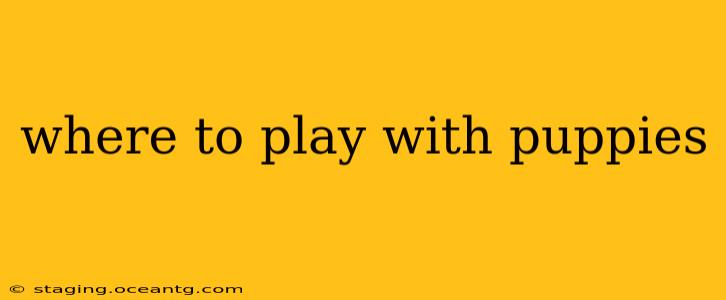Finding the perfect place to play with your adorable new puppy is crucial for their socialization, development, and overall well-being. Choosing the right environment ensures a safe and enriching experience for your furry friend. This guide explores various locations and provides tips for safe and fun puppy playtime.
What Makes a Good Puppy Play Area?
Before we dive into specific locations, let's define the ideal characteristics of a puppy play area:
- Safety First: The area should be free from hazards like traffic, toxic plants, sharp objects, and potential sources of infection. Fencing is essential to prevent escapes.
- Cleanliness: A clean environment minimizes the risk of parasites and diseases.
- Controlled Environment: Ideally, the area should offer some shade and protection from the elements.
- Stimulation: The space should provide opportunities for exploration, sniffing, and play. A varied environment is best.
- Supervision: Constant supervision is paramount, especially for young puppies who are prone to getting into trouble.
Where Can I Play with My Puppy?
Now let's explore various options for puppy playtime:
1. Your Own Backyard:
This is often the easiest and most convenient option. Ensure your yard is securely fenced, free of hazards (like poisonous plants or exposed wires), and cleaned regularly. Provide toys, and supervise your puppy closely, especially if it’s a digger or climber!
2. Dog Parks:
Dog parks offer a great opportunity for socialization, but they come with some risks. Choose well-maintained, fenced-in parks that are designated for puppies or small dogs if your puppy is young or small. Always supervise your puppy carefully, as interactions with other dogs can sometimes be unpredictable. Check for any park rules regarding vaccinations.
3. Puppy Classes:
Puppy classes provide a structured environment for socialization and learning basic obedience. These classes are led by experienced trainers who can guide you on appropriate play and interaction techniques. This is a great option for first-time puppy owners.
4. Friends' Yards (with Permission!):
Playing with your puppy in a friend's secure yard can be a great way to provide variety and avoid monotony. Ensure your friend's yard is safe and that they are comfortable with your puppy. Communication is key!
5. Local Parks (with Caution):
While some local parks might seem appealing, remember to prioritize safety. Many parks aren't fully fenced, making escapes possible. If you choose a park, keep your puppy on a leash and restrict playtime to quiet, less crowded areas.
What if My Puppy is Too Young to Go to a Dog Park or Class?
For very young puppies (under 4 months old), it's often best to limit socialization to controlled settings like your backyard or short supervised visits to quiet areas. Focus on gentle play and positive interactions with familiar people and pets. Consult with your vet about the best timeframe to introduce your puppy to more social environments.
How Can I Make Puppy Playtime Safe and Fun?
- Puppy-Proofing: Before letting your puppy loose, thoroughly check the play area for hazards.
- Introduce Gradually: If using a new area, start with short sessions and gradually increase the playtime duration.
- Provide Appropriate Toys: Choose age-appropriate toys that are durable and stimulating.
- Observe Your Puppy: Pay attention to your puppy's body language; if they seem stressed or overwhelmed, end playtime.
- Clean Up: Always clean up after your puppy.
By following these guidelines, you can ensure that your puppy has a safe and enjoyable playtime experience, promoting positive development and strengthening your bond. Remember to always prioritize safety and have fun!
